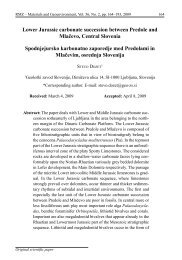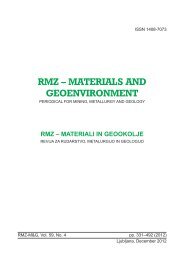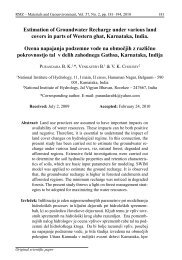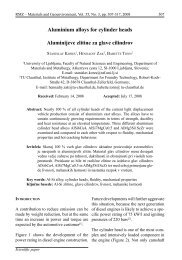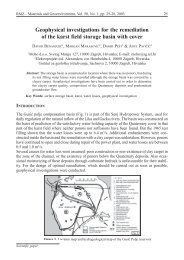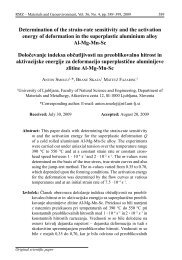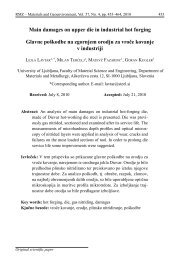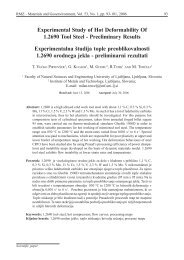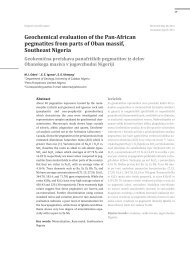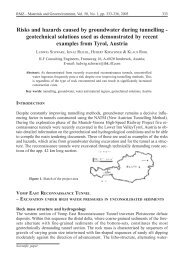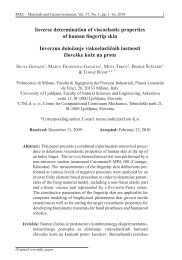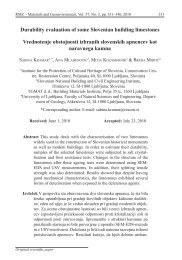Petrochemistry and genetic indicators of talcose rock of Esie ... - RMZ
Petrochemistry and genetic indicators of talcose rock of Esie ... - RMZ
Petrochemistry and genetic indicators of talcose rock of Esie ... - RMZ
You also want an ePaper? Increase the reach of your titles
YUMPU automatically turns print PDFs into web optimized ePapers that Google loves.
<strong>Petrochemistry</strong> <strong>and</strong> <strong>genetic</strong> <strong>indicators</strong> <strong>of</strong> <strong>talcose</strong> <strong>rock</strong> <strong>of</strong> <strong>Esie</strong> area, southwestern Nigeria<br />
365<br />
1981; Kayode, 1981; Elueze, 1982;<br />
Klemm et al, 1984; Ige & Asubiojo,<br />
1991;Truswell & Cope, 1963; Elueze,<br />
1982; Ogezi, 1977) (Figure 1). Previous<br />
researchers attributed pre-metamorphic<br />
parent <strong>rock</strong>s to peridotite (Elueze,<br />
1982), to magmatic origin (Ige &<br />
Asubiojo, 1991) or to tectonically emplaced<br />
slices <strong>of</strong> upper mantle material<br />
(Ogezi, 1977). The <strong>rock</strong>s in these areas<br />
are hardly preserved in their original<br />
state. Many bodies have suffered varying<br />
degrees <strong>of</strong> alteration <strong>and</strong> are extensively<br />
steatitized. Meta-utramafites<br />
are minor components <strong>of</strong> the Nigerian<br />
schist belts.<br />
The <strong>Esie</strong> schistose <strong>rock</strong>s have been<br />
considered by some workers in the<br />
past to lie within the Egbe-Isanlu schist<br />
belt exposed in southwestern Nigeria<br />
(Annor, 1981, Ige & Onabajo, 2005).<br />
However, the <strong>Esie</strong> <strong>talcose</strong> <strong>rock</strong> actually<br />
is a northern extension <strong>of</strong> Ife-Ilesha<br />
schist belt. It lies within latitudes<br />
<strong>of</strong> 4 0 45’–5 0 00’ North <strong>and</strong> longitudes<br />
8 0 00’–8 0 15’ East (Figure 1). The previous<br />
studies on the Ife Ilesha schistose<br />
<strong>rock</strong>s have generally focused on<br />
tectonic modeling (Rahaman, 1976;<br />
Olade & Elueze, 1979; Ajayi, 1981)<br />
<strong>and</strong> stratigraphic correlation (Klemm<br />
et al, 1983) with interpretations being<br />
based on major <strong>and</strong> trace element data.<br />
The <strong>Esie</strong> <strong>talcose</strong> <strong>rock</strong> have been studied<br />
mainly for their economic potential<br />
(Olorunfemi, 2007; Olorunfemi et<br />
al., 2009) <strong>and</strong> archaeological features<br />
(Olabanji et al., 1989; Ige & Onabajo,<br />
2005).<br />
The present study therefore, focuses<br />
on elucidating the origin <strong>and</strong> petrochemical<br />
characteristics <strong>of</strong> the <strong>talcose</strong><br />
<strong>rock</strong> <strong>of</strong> <strong>Esie</strong> area in the northern part<br />
<strong>of</strong> Ife-Ilesha schist belt, <strong>and</strong> is expected<br />
to contribute to the knowledge <strong>of</strong> the<br />
geodynamic evolution <strong>of</strong> the schist belt<br />
in Nigeria.<br />
Materials <strong>and</strong> Methods<br />
For this purpose a systematic geological<br />
mapping was undertaken on a scale<br />
<strong>of</strong> 1 : 25,000. Optical (thin section)<br />
<strong>and</strong> X Ray Diffraction studies were<br />
carried out in order to underst<strong>and</strong> the<br />
mineralogical composition. For the<br />
XRD determinations, powders <strong>of</strong> representative<br />
samples <strong>of</strong> six <strong>of</strong> the talc<br />
bodies were examined using a Philips–<br />
PW1011 model diffractometer. The<br />
diffractograms were recorded using a<br />
scanning rate 2 o min –1 cm –1 with a Nifiltered<br />
Fe K-alpha radiation.<br />
Twelve pulverized samples <strong>of</strong> the <strong>rock</strong><br />
unit were also chemically analyzed<br />
for major, trace <strong>and</strong> rare earth element<br />
composition by inductively coupled<br />
plasma–mass spectrometry (ICP-MS)<br />
instrumentation method at the Activation<br />
Laboratory Ontario, Canada. The<br />
detailed analytical procedure is described<br />
in Olorunfemi (2007).<br />
<strong>RMZ</strong>-M&G 2010, 57



